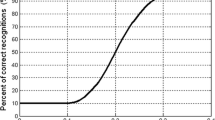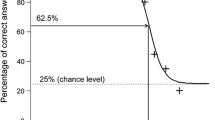Abstract
Background
A high reproducibility of visual acuity estimates is important when monitoring disease progression or treatment success. One factor that may affect the result of an acuity measurement is the duration of optotype presentation. For times below 1 s, previous studies have convincingly shown that acuity estimates increase with presentation duration. For durations above 1 s, the situation is less clear.
Methods
We have reassessed this issue using the Freiburg Visual Acuity Test with normal subjects. Presentation durations of 0.1 s, 1 s, and 10 s were assessed.
Results
Confirming previous findings, in all subjects acuity estimates in the 1-s condition were higher than those in the 0.1-s condition, on average nearly by a factor of 2, equivalent to 3 lines. However, in 12 out of 14 subjects, acuity estimates increased further with a presentation duration of 10 s, on average by 23% (P = 0.002), or roughly 1 line. Test–retest variability improved by 49% (P = 0.003). These findings can be explained by a simple statistical model of acuity fluctuations. Cognitive processing may also be a relevant factor. Interestingly, most observers subjectively felt that they could perceive the optotypes best in the 1-s condition.
Conclusion
The results highlight the importance of standardizing presentation durations when high reproducibility is required.




Similar content being viewed by others
References
Graham CH, Cook C (1937) Visual acuity as a function of intensity and exposure-time. Am J Psychol 49:654–661
Monjé M, Schober H (1950) Vergleichende Untersuchungen an Sehproben für die Fernvisusbestimmung. Klin Monatsbl Augenheilkd 117:561–570
Zanen J, Klaassen-Nenquin E (1957) Acuité visuelle en fonction du temps d’exposition. Bull Soc Belge Ophtalmol 114:574–581
Schwarz F (1947) Der Einfluß der Darbietungszeit auf die Erkennbarkeit von Sehproben. Pflügers Arch 249:354–360
Schwarz F (1951) Neue Sehschärfenmessungen: Die Prüfung der Sehleistung unter Berücksichtigung der Darbietungszeit der Sehproben. Graefes Arch Ophthalmol 151:714–724
Ehlers H (1948) On visual velocity. Acta Ophthalmol 26:115–121
Gerbstädt U (1949) Der Einfluß der Sehprobengröße auf die minimale Darbietungszeit. Pflügers Arch 251:559–570
Baron WS, Westheimer G (1973) Visual acuity as a function of exposure duration. J Opt Soc Am 63:212–219
Kono M, Yamade S (1996) Temporal integration in diseased eyes. Int Ophthalmol 20:231–239
von Boehmer H, Kolling GH (1998) Zusammenhang zwischen Sehschärfe und Darbietungszeit einzelner Landoltringe bei Normalpersonen und bei Nystagmus-Patienten. Ophthalmologe 95:717–720
Ng J, Westheimer G (2002) Time course of masking in spatial resolution tasks. Optom Vis Sci 79:98–102
Westheimer G (1987) Visual acuity. In: Moses RA, Hart WM (eds) Adler’s physiology of the eye, 8th edn. Mosby, St. Luis, pp 415–428
Charman WN, Heron G (1988) Fluctuations in accommodation: a review. Ophthalmic Physiol Opt 8:153–164
Stark L, Campbell FW, Atwood J (1958) Pupil unrest: an example of noise in a biological servomechanism. Nature 182:857–858
Montés-Micó R (2007) Role of the tear film in the optical quality of the human eye. J Cataract Refract Surg 33:1631–1635
Bach M (1996) The “Freiburg Visual Acuity Test” — Automatic measurement of the visual acuity. Optom Vis Sci 73:49–53
Liebeman HR, Pentlant AP (1982) Microcomputer-based estimation of psychophysiological thresholds: the best PEST. Behav Res Methods Instrument 14:21–25
Bland JM, Altman DG (1999) Measuring agreement in method comparison studies. Stat Methods Med Res 8:135–160
Bartlett NR (1965) Thresholds as dependent on some energy relations and characteristics of the subject. In: Graham CH (ed) Visual perception. Wiley, New York, pp 154–184
Metropolis N, Ulam S (1949) The Monte Carlo method. J Am Statist Ass 44:335–341
Arditi A, Cagenello R (1993) On the statistical reliability of letter-chart visual acuity measurements. Invest Ophthalmol Vis Sci 34:120–129
Acknowledgements
This study was supported by the Deutsche Forschungsgemeinschaft (BA 877/18). We are grateful to our subjects for their participation.
Author information
Authors and Affiliations
Corresponding author
Rights and permissions
About this article
Cite this article
Heinrich, S.P., Krüger, K. & Bach, M. The effect of optotype presentation duration on acuity estimates revisited. Graefes Arch Clin Exp Ophthalmol 248, 389–394 (2010). https://doi.org/10.1007/s00417-009-1268-2
Received:
Revised:
Accepted:
Published:
Issue Date:
DOI: https://doi.org/10.1007/s00417-009-1268-2




